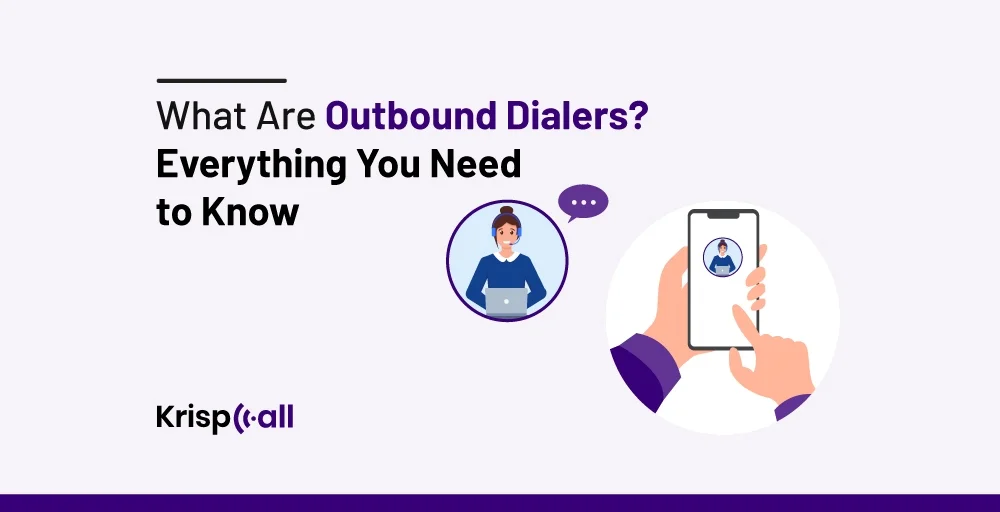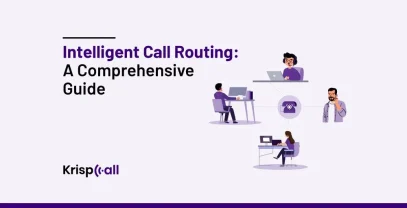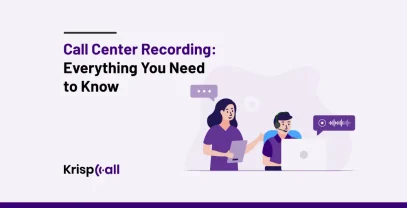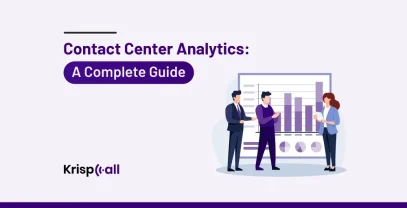How often do you spend valuable time and resources manually dialing phone numbers to reach out to your customers? 😞 Or does your business struggle to keep up with the increased demand of outbound calling?
If yes, then don’t worry! 🙂 With outbound dialers, you can overcome your communication challenges. As opposed to manual dialing, they streamline and optimize your outbound calling processes.
In this article, we’ll talk about what outbound dialers are, how dialers work, and what are their types & benefits. Furthermore, we’ll discuss how you can choose the right outbound dialer for your business so that you can reach more prospects, qualify leads faster, and boost your sales efficiency. 🎉
🔑 KEY HIGHLIGHTS
- Outbound dialer is a software program used in telecommunications and call centers to make outgoing phone calls to a large number of recipients.
- Outbound dialers automatically dial phone numbers from a database and connect answered calls to available agents.
- Power dialers, preview dialers, progressive dialers, and predictive dialers are the most common types of dialers.
- You can improve operational efficiency, increase productivity, and increase lead responses as a benefit of outbound dialers.
What Are Outbound Dialers?
The outbound dialer is a software program typically used in call centers to make outgoing phone calls to a large number of recipients. These systems are designed to streamline and optimize outbound calling processes by automatically dialing phone numbers from a pre-defined list, connecting agents to live calls, and managing call outcomes efficiently.
Outbound dialers can be programmed to handle various call types, including sales calls, follow-up calls, appointment reminders, and customer satisfaction surveys.
Furthermore, to discuss the benefits, outbound dialers help improve contact rates and reduce agent idle time, resulting in increased productivity. Moreover, utilizing features such as call scripting, call recording, and performance analytics can be extremely useful.
As a result, it allows your agent to have enhanced performance and customer interactions. Lastly, this dialer is mostly used to automate and manage outbound call campaigns.
According to statistics, typical B2B technology sales reps spend about 55 minutes per day speaking to prospects, which is an average of 35 calls per day. That means if your team has diverse skill sets and levels, choosing a dialer that can be used and deployed easily is a big deal.
How Do Outbound Dialers Work?

Outbound dialers work by automatically dialing phone numbers from a database and connecting answered calls to available agents. It can also be done through playing pre-recorded messages. They can utilize various dialing modes such as preview, predictive, and progressive.
The following is a step-wise procedure that outlines how outbound dialers work in the simplest way possible.
- A list of phone numbers to call is prepared by the agent before the call is made.
- The system predicts when agents will be available and dials accordingly.
- Dials numbers as agents become available.
- The agent interacts with the customer.
4 Outbound Dialer Types
There are several types of outbound dialers available, each serving a different purpose and need. For instance, an auto dialer designed for an outbound call center will need different features than one designed for a school or law firm. In order to make a better choice, let’s take a moment to look at four types of outbound dialers:
1. Power Dialers
Power dialers are essential tools for sales organizations that rely heavily on outbound calling. This dialer employs an algorithm to detect call progress, which means it can differentiate between various call scenarios, such as calls going into voicemails, busy signals, missed calls, or live answers.
Through this software, you can automatically handle each call outcome appropriately. Moreover, Power dialers help streamline their outbound calling processes and improve sales performance.
2. Preview Dialers
A preview dialer is software that allows you to preview your caller details before picking up the phone. They can analyze relevant information about customers, such as names, contact details, previous interactions, and purchase history. As a result, sales representatives can offer personalized services to the customer, building relationships.
3. Progressive Dialers
A progressive dialer is a type of telephone dialing system that dials a single number at a timer rather than multiple numbers simultaneously. The outgoing call process can be sped up with progressive dialers.
Meanwhile, progressive dialers can decrease preparation time, which can affect call quality. Therefore, they’re better suited to campaigns where they need to focus on individual calls and provide high-quality service while still maintaining a high level of productivity and efficiency.
4. Predictive Dialers
Predictive dialers are calling software that uses AI technology and statistical algorithms to automatically dial phone numbers and connect answered calls to available agents. Not only that but with these, you can dial multiple numbers estimating the agent’s call duration and availability to maximize connectivity and minimize the time agents spend not talking to contacts.
Also, by using predictive dialers, large volumes of calls can be handled by synchronizing auto-dialing with agent availability. This solution for high-volume call centers can achieve optimal outbound agent productivity.
Key Features of Outbound Dialers
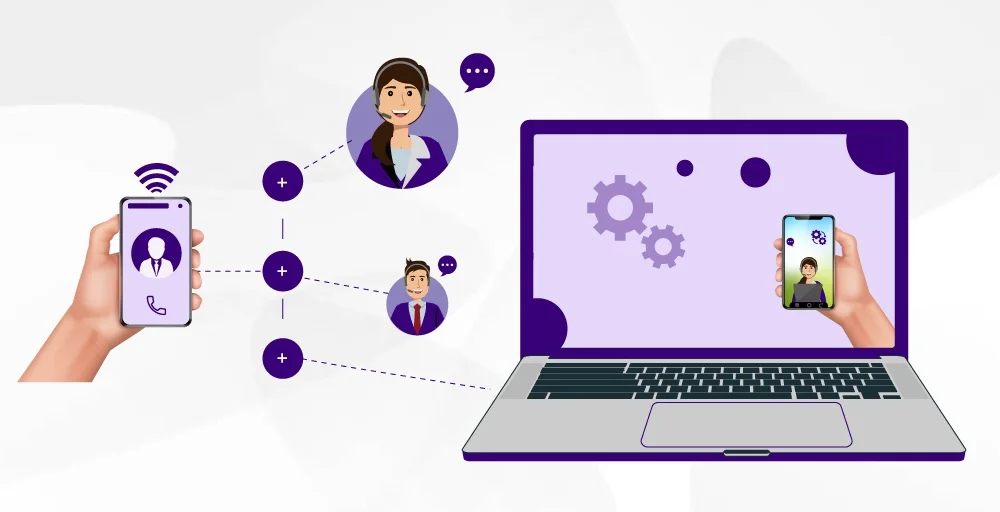
Many business organizations use outbound dialers to initiate outgoing calls to their customers or prospects in order to generate business leads. Using these tools, organizations can automate the process of reaching out to contacts. Additionally, this enables them to manage the communication efforts that they undertake effectively.
Aside from this, there are a number of key features that can be found in outbound dialing systems, some of which are:
- Predictive Dialing: With the help of this feature, you can predict the time at which a contact is likely to be available to answer your call based on a number of variables. This includes agent & customer availability based on historical call data. As a result, you can minimize the idle time between calls, which maximizes agent productivity and efficiency.
- Call Routing: Predefined criteria, such as skill set, language proficiency, or geographic location, can guide outbound dialers to assign calls to the most appropriate agent. To ensure that callers receive the best service possible, most outbound dialers also have a call routing feature.
- Call Recording: For quality assurance, training, or compliance reasons, many outbound dialer systems allow you to record outgoing calls. It is possible to review recorded calls later to evaluate agent performance and ensure compliance with regulations.
- Integration with CRM Systems: With CRM integration, outbound dialers can access customer data and call history stored in the CRM database. Through this integration, agents can access relevant customer data during outbound calls, resulting in more personalized customer service.
- Real-time Analytics and Reporting: With outbound dialers that have this capability. With this, supervisors can monitor key metrics such as agent performance, call volume, and campaign effectiveness in real-time. By analyzing these insights, managers can take steps to optimize outbound calling.
Benefits of An Outbound Dialer: Why Would A Company Want To Use It?
An outbound dialing system helps your team do their job more efficiently and effectively, whether it’s connecting customers to the brand or starting a call about customer service information.
However, among many, the four most important benefits are as follows:
1. Improves Operational Efficiency and Call Value With Integrations
Outbound call center solutions that include auto-dialing tools are the most effective. Additionally, they can also be integrated with tools such as customer relationship management (CRM), productivity tools, and collaboration tools.
For instance, a predictive dialer can be integrated with HubSpot, Salesforce, Microsoft Dynamics 365, and Zapier, to name a few.
It is possible to streamline work by integrating these applications together. It lets you have access to customer data and history before or during the call and also does the dialing process.
2. Agent Productivity and Efficiency
In addition to saving time, an outbound dialer helps you reach the next number or the next call more quickly. Additionally, outbound dialers can connect agents with potential leads automatically after filtering out busy signals and no-response numbers.
This means that an outbound dialer connects agents to live calls much faster, which allows them to handle more calls in less time. As a result, you can increase your productivity and efficiency by reducing the time agents spend on manual dialing and waiting for the next call.
3. Increases Lead Response Times and Conversions
Generally, sales representatives are more likely to convert customers if they execute callbacks quickly. By automating callbacks based on customer preferences, auto-dialers speed up lead response times.
Within a fast-paced context, it becomes easy for agents to prioritize the leads based on factors such as lead score or recency. This helps to ensure that agents focus on the most promising opportunities.
4. Coaching and Quality Management
Did you know? With low response rates of around 5% customer satisfaction scores tend to be skewed. The happiest (and angriest) customers tend to get the best scores or vice versa. So, how can this be dealt with? – with quality management!
During outbound dialing, calls are recorded and monitored, often for quality assurance and training purposes. Thus, you can improve the customer satisfaction score (CSAT) of your agents as well as improve their performance. In addition to identifying improvement areas for reps, this rating is useful for contact center managers as well.
5. Contact List Creation And Campaign Management
An outbound dialer helps companies manage their contact lists and campaign strategies more effectively. With this, you can segment your contact lists based on various criteria such as demographics or behavior, and automate the campaign workflow. As a result, it allows your teams to focus on other (more important) aspects of the business.
Use Cases for Outbound Dialer Software in Different Industry
A compound annual growth rate of 37% is expected for the predictive dialer software market between 2021 and 2028. This means their use will definitely increase. The use of outbound dialers can drive sales more efficiently for some industries than others because they are effective tools for interacting with leads and customers in all industries.
Talking of the present, to give you a better idea of how it has helped businesses achieve outstanding results, here are some examples:
Creating Sales and Marketing Strategies
Outbound dialers can help sales and marketing teams increase their call volume and productivity. By automatically dialing numbers and filtering out busy signals, voicemails, and no-answers, agents can spend more time speaking with potential customers.
Additionally, outbound dialers can be integrated with CRM systems like Salesforce and HubSpot. Because of this, agents can have access to customer information and history before making a call.
A Debt-Collecting Agency
Outbound dialers can help debt collection agencies increase their contact rates and collect payments more efficiently. Predictive dialers, in particular, can help agents reach a high volume of contacts in a short amount of time.
Additionally, outbound dialers can also be integrated with debt collection software, which presumably allows agents to access account information and payment history before making a call.
The Healthcare System
Outbound dialers can help healthcare organizations improve patient engagement and satisfaction. For example, healthcare providers can use outbound dialers to remind patients of upcoming appointments, follow up on patient surveys, or provide medication reminders.
Additionally, outbound dialers can integrate with electronic health record (EHR) systems. This means that you can allow agents to access patient information and history before making a call.
How To Choose The Right Outbound Dialer For You?
When deciding which outbound dialer is best for you, it is best to consider your particular needs and objectives. The following factors will help you choose the right outbound dialer.
1. Identify Your Needs
Primarily, assess your organization’s unique requirements to determine what is most suitable for your organization. You should consider aspects such as
- How many outgoing calls you’ll make each day,
- The size and structure of your team, and
- What type of campaigns you’re going to conduct, like sales, customer service, fundraising, etc?
By understanding your business objectives upfront, you can choose an outbound dialer that supports your business objectives effectively without having unnecessary features.
2. Evaluate Features
You should evaluate outbound dialer solutions based on the features they offer once you have identified your needs. There are a number of key functionalities to look for, such as automated dialing modes (predictive, power, preview),
When choosing an outbound dialer, you should also look for options like integrations with CRMs for seamless access and management of customer data and reporting and analytics for monitoring agent productivity and campaign results. Decide what features you require to achieve your goals and prioritize solutions that offer them.
3. Consider Scalability and Compatibility
If you are choosing an outbound dialer, take your organization’s future growth into consideration. Make sure your chosen solution can handle increasing call volumes and evolving business requirements without needing major modifications.
In addition, it is important to ensure that your outbound dialer works seamlessly with your existing software, including your CRM software, your contact databases, and communication channels. The more compatible your operations, the more efficient they will be and the fewer disruptions there will be.
Outbound Dialer Best Practices: How to Make the Most of Your Choice?
To make the most of the dialer you are using, you should follow some best practices including
1. Optimize Your Outreach to Avoid Being Flagged or Blocked.
Using auto-dialers allows you to make calls quickly at high volumes – but that doesn’t mean you should always be dependent on those.
If you make dozens of calls daily to your clients or customers, your carriers may flag your calls as spam if they consider them excessive. Moreover, customers may be hesitant to call you if they see your number as a “spam call.” There is even a possibility of your number being blocked completely.
Make sure your calling volumes are optimized to avoid this. You can, for instance:
- Reduce the number of calls you make by incorporating email and SMS into your outreach strategy.
- Make sure your caller ID reputation is in good shape by performing regular reputation management.
- Limit the number of calls a lead can receive in a day, week, or month.
- Make sure your calling strategy allows for rest periods during which you cannot contact the customer.
2. Prioritize Leads
It can be difficult for some businesses to manage high lead volumes while at the same time maintaining agent productivity, which is why they use outbound dialer services. To maximize the volume of potential conversions, it is necessary to be able to call leads in quick succession. Despite this, not every lead is the same.
In order to prevent your competitors from snatching up high-quality leads as soon as they come in, you need to contact them as soon as they come in. It is recommended to use an auto-dialer that allows you to respond quickly to changing priorities as a best practice.
3. Monitor and Analyze Performance
Monitoring and analyzing your newly implemented autodialer’s impact on your performance should be done on a regular basis. Is the productivity of agents higher? Is the number of leads converted increasing? Is the investment returning a profit?
In addition to real-time analytics and reporting, some auto dialers offer real-time reporting. Then you can determine if your auto dialer implementation has been successful based on an abundance of call data.
Here are some metrics to consider:
- The rate of calls dropped
- Agents’ call volume
- Time spent handling calls on average
- Lead conversion ratio
- Per-call cost
Your team’s performance can be better assessed, and areas for improvement can be identified by analyzing this data.
Final Thoughts
Regardless of your industry, outbound dialers can significantly improve your communication strategy. With outbound dialers, you can reach more customers, streamline your operations, and improve results by automating the process of making outgoing calls.
An outbound dialer offers a comprehensive way to enhance your outbound communication efforts. It is equipped with functionalities like automated dialing modes, CRM integration, and compliance tools. With the right outbound dialer, you can take your company’s communication to the next level.

